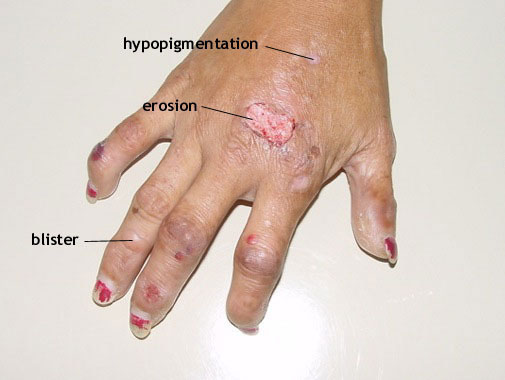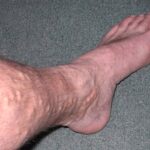Variegate porphyria (VP) is a rare genetic disorder that affects heme biosynthesis—the process responsible for producing heme, an essential component of hemoglobin. Caused by mutations in the PPOX gene, this autosomal dominant condition leads to the accumulation of porphyrin precursors in the body, triggering both neurovisceral and cutaneous symptoms. VP is one of the hepatic porphyrias and can present acutely or through chronic skin involvement.

Genetic Basis of Variegate Porphyria
VP results from mutations in the protoporphyrinogen oxidase (PPOX) gene located on chromosome 1q22. This enzyme catalyzes the conversion of protoporphyrinogen IX to protoporphyrin IX in the heme biosynthesis pathway. Deficiency of PPOX results in the buildup of porphyrin intermediates, particularly during metabolic stress, fasting, or exposure to certain drugs.
Inheritance Pattern
- Autosomal dominant inheritance with variable expressivity
- Penetrance is incomplete; many carriers remain asymptomatic
- Triggering factors are often required to provoke symptomatic episodes
Clinical Manifestations of Variegate Porphyria
Acute Neurovisceral Attacks
Acute symptoms resemble other forms of acute hepatic porphyrias and may include:
- Severe abdominal pain (not associated with inflammation)
- Nausea, vomiting, constipation
- Neuropathy (motor weakness, sensory disturbances)
- Psychiatric manifestations (anxiety, hallucinations, confusion)
- Hypertension and tachycardia
- Seizures in severe cases
These symptoms are often episodic and can be life-threatening if untreated.
Cutaneous Symptoms
Cutaneous manifestations are due to photosensitivity and may occur independently of acute attacks:
- Fragile skin on sun-exposed areas
- Blistering and erosion, particularly on hands and face
- Scarring and hyperpigmentation
- Secondary infections due to open lesions
Triggers and Aggravating Factors
Several exogenous and endogenous factors can precipitate acute attacks in individuals with VP:
- Medications: Barbiturates, sulfonamides, certain antibiotics, hormonal treatments
- Fasting or crash dieting
- Alcohol consumption
- Infections and stress
- Hormonal fluctuations (especially during menstruation)
- Sunlight exposure (cutaneously active cases)
Diagnosis of Variegate Porphyria
Accurate diagnosis requires a comprehensive evaluation, including biochemical and genetic testing.
Biochemical Screening
- Urine porphobilinogen (PBG) – Often elevated during acute attacks
- Plasma fluorescence emission scan – Emission peak at ~626 nm is characteristic of VP
- Stool porphyrins – Elevated levels of coproporphyrins and protoporphyrin
- Urine porphyrins – Elevated uroporphyrins and heptacarboxyporphyrins
Genetic Testing
- Identification of PPOX gene mutation confirms diagnosis
- Useful for family screening and asymptomatic carriers
Differential Diagnosis
VP shares overlapping features with other porphyrias and non-porphyric conditions:
- Acute Intermittent Porphyria (AIP) – Primarily neurovisceral with no cutaneous signs
- Hereditary Coproporphyria (HCP) – Similar neurovisceral features; differentiable by stool porphyrin profile
- Porphyria Cutanea Tarda (PCT) – Cutaneous involvement without acute attacks
Treatment and Long-Term Management
Acute Attack Management
- Hospitalization for severe symptoms
- Intravenous hemin (heme arginate) – Suppresses ALA synthase, halting porphyrin precursor accumulation
- Glucose infusion – High carbohydrate load helps downregulate heme synthesis
- Symptom management – Analgesics, antiemetics, seizure control (avoid contraindicated drugs)
Cutaneous Management
- Strict photoprotection – Sunscreen, protective clothing
- Beta-carotene supplementation – Increases melanin tolerance
- Wound care – Prevention of infection and scarring
Preventive Measures
- Avoidance of known triggers – Drugs, alcohol, fasting
- Regular monitoring of liver and kidney function
- Family counseling – Genetic risk and preventive education
- Medic Alert Identification – In case of emergency
Prognosis and Complications
Most individuals with VP can lead a normal life with proper management and trigger avoidance. However, complications may arise:
- Chronic neuropathy following multiple attacks
- Chronic skin damage and scarring
- Increased risk of hepatocellular carcinoma in long-standing hepatic porphyrias
Current Research and Advances
Emerging therapies aim to enhance quality of life and reduce attack frequency:
- RNA interference (RNAi) therapy to inhibit ALA synthase-1 expression
- Gene therapy trials targeting PPOX mutation correction
- Improved hemin formulations for home infusion
- Biomarker development for early attack prediction
Research remains active in expanding therapeutic options and reducing disease burden.
Variegate porphyria is a complex metabolic disorder requiring a multidisciplinary approach for diagnosis and management. Through early detection, patient education, lifestyle modifications, and access to specialized care, individuals affected by VP can significantly reduce the frequency and severity of symptoms, maintaining a high quality of life. Continued research and awareness are critical to advancing care and uncovering new therapeutic strategies.

